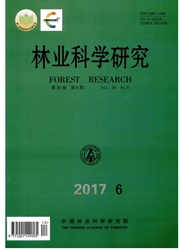

 中文摘要:
中文摘要:
对江西大岗山地区不同发育阶段杉木林林地土壤有机碳变化特征进行了研究,并利用相关分析和逐步回归分析方法探讨了土壤因子对其的影响。结果表明,不同发育阶段土壤有机碳含量随土壤深度的增加而降低,各层次有机碳含量表现出明显的变异特征,变异程度为:40-60 cm土层〉20-40 cm土层〉0-20 cm土层,其中中龄林土壤变异最为显著;随杉木的生长发育,土壤有机碳含量从幼龄林到中龄林呈下降趋势,中龄林到过熟林则呈上升趋势;土壤有机碳含量与全N量、碱解N量、有效P含量等土壤因子密切相关;建立的从幼龄林到过熟林各阶段的土壤有机碳回归方程具有较高的回归精度,比较标准化回归系数法处理显示,土壤N状况是影响土壤有机碳变异的主导因子。
 英文摘要:
英文摘要:
The variation characteristics of soil organic carbon (SOC) in different developing stages of Chinese fir plantations were studied in Dagang mountain of Jiangxi Province. Correlation analysis and stepwise regression analysis were used to investigate the influence of soil factors on SOC content. Results showed that SOC content decreased with increasing soil depth. Significant variation characteristics of SOC content were found in different soil layers, with coefficient variation in the order of 40 -60 cm 〉 20 -40 cm 〉 0 -20 cm, especially in the medium forest soil. With the growth and development of Chinese fir plantations, SOC content decreased from juvenile to medium, and then increased from medium to over-mature. The SOC content had close correlations with total nitrogen content and alkali-hydrolyzable nitrogen content. The SOC regression equations in different developing stages of Chinese fir plantations were established with high regression estimation precision. Compared Beta suggested that soil nitrogen was the leading factor of SOC content variation.
 同期刊论文项目
同期刊论文项目
 同项目期刊论文
同项目期刊论文
 Foliar and soil N-15 natural abundances provide field evidence on nitrogen dynamics in temperate and
Foliar and soil N-15 natural abundances provide field evidence on nitrogen dynamics in temperate and CO2 Flux Estimation by Different Regression Methods from an Alpine Meadow on the Qinghai-Tibetan Pla
CO2 Flux Estimation by Different Regression Methods from an Alpine Meadow on the Qinghai-Tibetan Pla Rice to vegetables: short versus long-term impact of land use change on the indigenous soil microbia
Rice to vegetables: short versus long-term impact of land use change on the indigenous soil microbia C-13 abundance, water-soluble and microbial biomass carbon as potential indicators of soil organic c
C-13 abundance, water-soluble and microbial biomass carbon as potential indicators of soil organic c Spatiotemporal dynamics of aboveground primary productivity along a precipitation gradient in Chines
Spatiotemporal dynamics of aboveground primary productivity along a precipitation gradient in Chines Mechanism and bio-environmental controls of ecosystem respiration in a cropland in the North China P
Mechanism and bio-environmental controls of ecosystem respiration in a cropland in the North China P Litter production, leaf litter decomposition and nutrient return in Cunninghamia lanceolata plantati
Litter production, leaf litter decomposition and nutrient return in Cunninghamia lanceolata plantati Responses to N and P fertilization in a young Eucalyptus dunnii plantation: Microbial properties, en
Responses to N and P fertilization in a young Eucalyptus dunnii plantation: Microbial properties, en Effects of vegetation control on ecosystem water use efficiency within and among four grassland ecos
Effects of vegetation control on ecosystem water use efficiency within and among four grassland ecos 期刊信息
期刊信息
